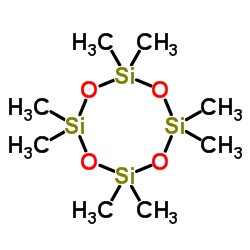Octamethylcyclotetrasiloxane

Octamethylcyclotetrasiloxane structure
|
Common Name | Octamethylcyclotetrasiloxane | ||
|---|---|---|---|---|
| CAS Number | 556-67-2 | Molecular Weight | 296.616 | |
| Density | 1.0±0.1 g/cm3 | Boiling Point | 175.0±0.0 °C at 760 mmHg | |
| Molecular Formula | C8H24O4Si4 | Melting Point | 17-18 °C(lit.) | |
| MSDS | Chinese USA | Flash Point | 63.2±23.0 °C | |
| Symbol |


GHS02, GHS08 |
Signal Word | Warning | |
|
Siloxane treatment by adsorption into porous materials.
Environ. Technol. 30(10) , 1073-83, (2009) Siloxanes are widely used in different applications: health care, dry cleaning, household products, paints and coatings, paper, personal care, for example. This explains their prevalence in the environment. Because of their volatile nature, most of the time t... |
|
|
Allometric relationships to liver tissue concentrations of cyclic volatile methyl siloxanes in Atlantic cod
Environ. Pollut. 190 , 109-14, (2014) Spatial distribution and relationship of allometric measurements (length, weight and age) to liver concentrations of cyclic volatile methyl siloxanes (cVMS) including octamethylcyclotetrasiloxane (D4), decamethylcyclopentasiloxane (D5) and dodecamethylcyclosi... |
|
|
[Analysis of the volatile oils chemical constituents of roots of Actinidia deliciosa].
Zhong Yao Cai 31(5) , 677-8, (2008) To analyze the volatile oils chemical constituents of roots of Actinidia deliciosa.The volatile oils fraction of roots of Actinidia deliciosa. were extracted by water vapor distilling, and then the constituents were separated and identified, by GC-MS.16 compo... |
|
|
A two-generation reproductive toxicity study of octamethylcyclotetrasiloxane (D4) in rats exposed by whole-body vapor inhalation.
Reprod. Toxicol. 23(2) , 202-15, (2007) This study evaluated the potential toxicity of whole-body vapor inhalation of octamethylcyclotetrasiloxane (D(4)) on reproductive capabilities in exposed F(0) and F(1) parental animals and the potential effects on neonatal survival, growth, and development of... |
|
|
Route-specific differences in distribution characteristics of octamethylcyclotetrasiloxane in rats: analysis using PBPK models.
Toxicol. Sci. 71(1) , 41-52, (2003) Octamethylcyclotetrasiloxane (D(4)) is used in selected consumer products and has a potential for human exposure from multiple routes. Here we develop a physiologically based pharmacokinetic (PBPK) model to describe the tissue dosimetry, plasma concentration,... |
|
|
In vitro and in vivo percutaneous absorption of 14C-octamethylcyclotetrasiloxane (14C-D4) and 14C-decamethylcyclopentasiloxane (14C-D5).
Regul Toxicol Pharmacol 50(2) , 239-48, (2008) Octamethylcyclotetrasiloxane (D4) and decamethylcyclopentasiloxane (D5) are cyclic siloxanes used as chemical intermediates with some applications in consumer products. The in vitro percutaneous absorption of 14C-D4 and 14C-D5 was studied in flow-through diff... |
|
|
Inhalation dosimetry modeling with decamethylcyclopentasiloxane in rats and humans.
Toxicol. Sci. 105(2) , 275-85, (2008) Decamethylcyclopentasiloxane (D(5)), a volatile cyclic methyl siloxane (VCMS), is used in industrial and consumer products. Inhalation pharmacokinetics of another VCMS, octamethylcyclotetrasiloxane (D(4)), have been extensively investigated and successfully m... |
|
|
Are highly lipophilic volatile compounds expected to bioaccumulate with repeated exposures?
Toxicol. Lett. 179(2) , 85-92, (2008) With non-volatile compounds, high lipophilicity (i.e., fat:blood partition coefficients, Pf, in the range of several hundred to a thousand or higher) typically leads to concerns for bioaccumulation. To evaluate the extent to which highly cleared, lipophilic v... |
|
|
An inhalation reproductive toxicity study of octamethylcyclotetrasiloxane (D4) in female rats using multiple and single day exposure regimens.
Reprod. Toxicol. 23(2) , 192-201, (2007) Octamethylcyclotetrasiloxane (D(4)) has been shown to have effects on the female rat reproductive cycle. This study evaluated the phase of the female rat reproductive cycle affected by D(4) using a study design that allowed the complete female reproductive cy... |
|
|
Effects of octamethylcyclotetrasiloxane (D4) on the luteinizing hormone (LH) surge and levels of various reproductive hormones in female Sprague-Dawley rats.
Reprod. Toxicol. 23(4) , 532-40, (2007) The objectives of this study were to assess the potential for D(4) to suppress the pre-ovulatory lutenizing hormone (LH) surge, to block or delay ovulation, and to evaluate potential effects on reproductive hormones in rats. Female Sprague-Dawley Crl:CD (SD) ... |